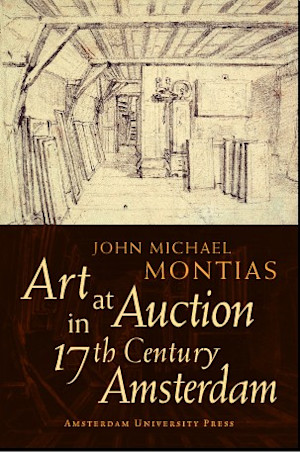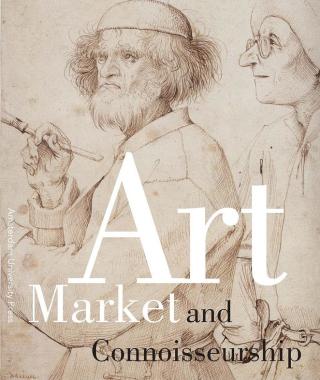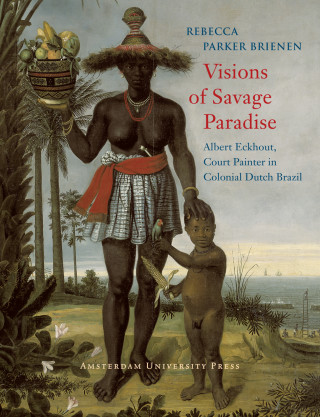
Vanaf 1 oktober worden Engelstalige AUP-boeken uitgegeven door Taylor & Francis. Meer informatie: AUP en Taylor & Francis werken samen aan Engelstalig boekenprogramma
J. Montias
Art at Auction in 17th Century Amsterdam
Tijdens de talloze veilingen die de Amsterdamse Weeskamer in de eerste helft van de Gouden zeventiende eeuw organiseerde, blijken het vooral koopmannen te zijn geweest, en dan met name uit de Zuidelijke Nederlanden en Holland, die hun goede geld investeerden in de aankoop van een Dürer of een Gerard Dou.
Op basis van vele originele documenten die door de Weeskamer zijn overgeleverd, heeft professor J.M. Montias voor het eerst de achtergronden van zo’n 2000 zeventiende-eeuwse kopers van veilingkunst systematisch geanalyseerd. Hij verzamelde gegevens over hun beroep, hun afkomst, hun religie, hun geboortejaar en huwelijksdata, de belasting die ze betaalden en andere aanwijzingen over hun welvaart. Daaruit blijkt dat de kopers in verschillende groepen geclusterd waren. Een aantal van hen – waaronder ook de schilders Rembrandt en Rubens – komt in het boek uitgebreid aan bod. Daarnaast analyseert Montias de onderwerpen van de gekochte kunst en de kunstenaars waaraan de kopers gelieerd waren.
Op basis van vele originele documenten die door de Weeskamer zijn overgeleverd, heeft professor J.M. Montias voor het eerst de achtergronden van zo’n 2000 zeventiende-eeuwse kopers van veilingkunst systematisch geanalyseerd. Hij verzamelde gegevens over hun beroep, hun afkomst, hun religie, hun geboortejaar en huwelijksdata, de belasting die ze betaalden en andere aanwijzingen over hun welvaart. Daaruit blijkt dat de kopers in verschillende groepen geclusterd waren. Een aantal van hen – waaronder ook de schilders Rembrandt en Rubens – komt in het boek uitgebreid aan bod. Daarnaast analyseert Montias de onderwerpen van de gekochte kunst en de kunstenaars waaraan de kopers gelieerd waren.
Auteur
- Titel
- Art at Auction in 17th Century Amsterdam
- Auteur
- J. Montias
- ISBN
- 9789048505166
- Uitvoering
- eBook PDF
- Aantal pagina's
- 336
- Taal
- Engels
- Publicatiedatum
- 07 - 11 - 2002
- Afmetingen
- 16 x 24 cm
- Open access
- Download op Open Access Platform
- Discipline
- History, Art History, and Archaeology
Table of Contents - 6
Acknowledgements - 8
Part I - The Auctions - 10
Introduction - 12
1 Orphan Chamber Auctions in Amsterdam - 16
2 How Auction Sales of the Orphan Chamber Were Conducted - 21
3 Extant Records of Auction Sales in Chronological Perspective - 28
4 Aggregate Statistics of Sales and the Owners of Goods Sold - 34
5 The Buyers at Auction Sales - 42
6 The Wealth of Buyers - 53
7 Clusters of Private Buyers - 58
8 Remonstrants and Counter-Remonstrants - 78
9 What Did They Buy and at What Prices? - 88
10 Attributions - 94
11 Echoes - 101
12 Concluding Words on Auctions - 109
Part II - Profiles of Selected Buyers - 112
Introduction - 114
13 Art Dealers I: Artists and Merchants in the Trade - 115
14 Art Dealers II: Johannes de Renialme - 115
15 Art Dealers III: The Story of a Merchant Who Thought He Could Sell Paintings to a King - 145
16 Art Collectors and Painters I: Rubens’s Promise to Hans Thijsz. - 154
17 Art Collectors and Painters II: Jacob Swalmius and Rembrandt - 165
18 Art Collectors and Painters III: Marten van den Broeck and Rembrandt's Losses at Sea - 181
19 Art Collectors and Painters IV: Jan van Maerlen and His Extended Family - 189
20 Art Collectors and Painters V: Jean le Bleu, François Venant and Rembrandt's "Feast of Belshazzar" - 205
21 A Collector with Connections to Major Cultural Figures: Robbert van der Hoeve and the "Muiden Circle" - 210
22 What Santa Claus Brought to the Youth of Amsterdam - 221
23 When Sellers and Buyers Were Related: Elbert and Cornelis Symonsz. Pool, Jeltge Claes, and Pieter Claesz. Codde - 227
24 A Collector Who Held On to His Purchase for Over Fifty Years - 235
25 An Afterword on Mentalités - 244
Bibliography - 248
Published Sources - 250
Notes - 258




